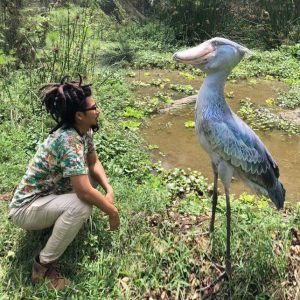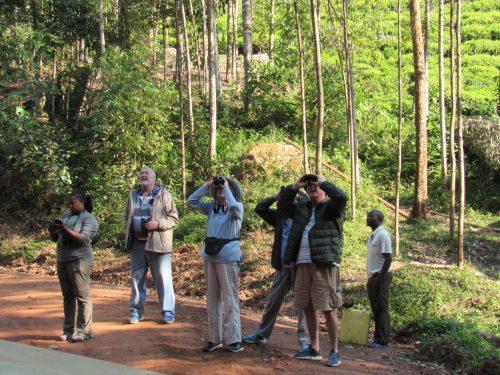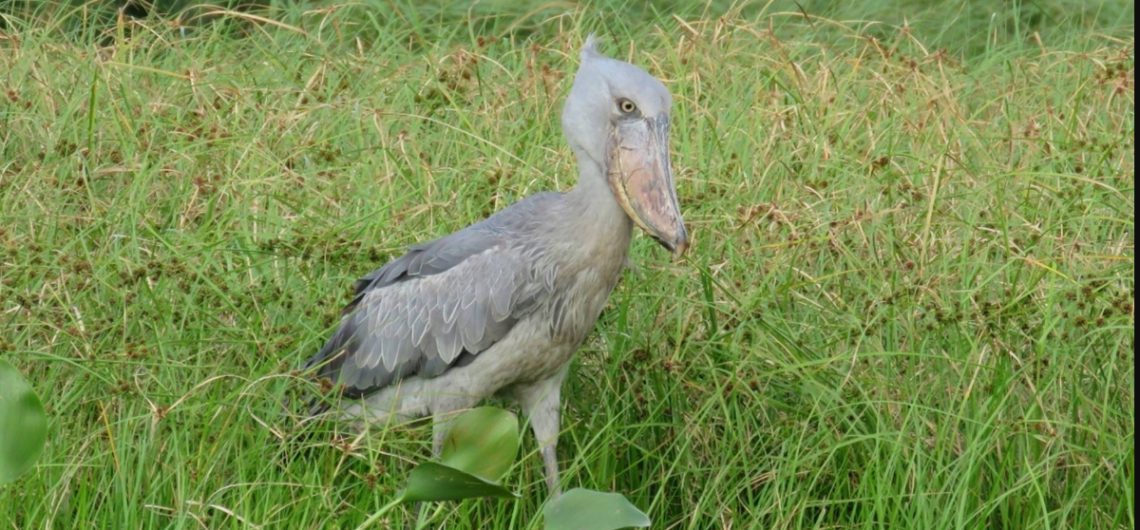Mabamba Swamp Tour in Uganda: Uganda is an ideal objective for birdwatching from everywhere the world. The wetland of Mabamba inlet is the best spot for the Shoebill Stork (Balaeniceps REX), Blue Swallow (Hirundo atrocad. The wetland was chosen in 2006 as a Ramsar Site and a wetland of global significance due to uncommon and alluring bird species, for example, the Papyrus Yellow Warbler. Mabamba swamp shoebill Tour in Uganda Mabamba Bay marsh is a wide waterlogged region extending through a long/little papyrus-filled channel around the external showers of Lake Victoria in Entebbe Uganda. This is home to 38% of blue swallow’s worldwide populace and home to the jeopardized yellow lark.
With global help, Uganda’s administration-controlled infringement onto the wetland and advanced it as a main birding objective. Sightseers on a Uganda safari make continuous stops in the locale to recognize birds like the blue and yellow larks, the papyrus gonolek, and the shoebill. Mabamba swamp is arranged on the shores of Lake Victoria west of Entebbe town possessing around 2424 hectares with bogs of papyrus, wetland grasses, and water lilies. Mabamba swamp is especially well known for the subtle shoebill stock which is for the most pursued bird species by birding travelers and nature darlings from all sides of the world.
Mabamba Swamp is viewed as an Important Birding Area and a Ramsar site. This immense bog is a home to north of 300 bird species comprehensive of locally and universally compromised species, the wetlands are likewise known for the groups of Palearctic traveler species among October and March. Other than the intriguing Shoebill stock other outstanding birds incorporate the papyrus Gonolek which is among 7 of 12 victoria biome confined species you can find in Uganda.
The most effective method to Reach Mabamba Swamp
Mabamba bog can be available both on water and land, the most straightforward course from Kampala or Entebbe is by ship by means of Nakiwongo landing site towards kasajja landing site with around 30 minutes. Too via land, you can utilize Kitende off Entebbe Street towards Sisa exchanging focus inside around 40mins. Birding in the Mabamba wetland is finished utilizing 2 methods relying upon your inclination; you can pursue a decision of a kayak ride through the bog or a mechanized wooden vessel and ride through tight water trails encompassed by swamps of papyrus.
Mabamba swamp is the most well-known and presents the greatest possibilities experiencing the uncommon shoebill stock. This bird is the most pursued bird species by birding sightseers visiting Uganda and, in some cases, different classifications of vacationers really do visit Mabamba to see and pleasant minutes with this curiously large and marvel looking bird. Shoebill must be found in a couple of spots all over East Africa among which Mabamba wetland is the most effectively open and presents the most obvious opportunity to locate get this bird species.
Human activities around Mabamba swamp
Mabamba Swamp is blessed with an assortment of Lungfish a known staple nourishment for the shoebill stock, in any case, lungfish makes contest between the human populace and the shoebills because of its high delicacy esteem among the encompassing Baganda people group. This accompanies one more experience of noticing fishing utilizing customary means. The anglers had long held a notion fantasy that seeing a Shoebill prior to fishing brings about unfortunate outcomes for that day. Notwithstanding, this is on the grounds that the Shoebill benefits from lungfish, and where the Shoebill is implied all the fish will move further into stowing away.
For the anglers, it was an unfortunate turn of events seeing a Shoebill and everybody couldn’t go into the wetland. The anglers depended on hunting the Shoebill species and killed them, this brought about a decrease in the quantities of these species, and shoebills are locally threatened to terminated. This wetland was periodical as a Ramsar site in 2006 to guarantee that the interesting shoebill stock is secured and furthermore large quantities of travelers visiting the wetland set up edification and finished this contention of the anglers and the local area.
The anglers at Mabamba swamp lease their boats to birding vacationers and acquire a ton out of this, and, surprisingly, a few anglers and local area individuals have been prepared and laid out their bird watching local escorts relationship in Mabamba. The anglers presently altogether partake in safeguarding the Shoebill stock, so at whatever point they set off to fish in the marsh and see a Shoebill they keep a distance way not to upset it and will happily illuminate the travelers about where to find it. The statistics shows around 15 species involving the wetland.

Best time to see the Shoebill in Mabamba swamp
The best opportunity to see the Shoebill in the Mabamba swamp during your visit is early morning between 7 am to 9 am, and late in the evening at around 5 pm. And furthermore, don’t miss an emotional encounter during noontime, the shoebill is scooping out lungfish from the mud for its lunch, subsequent to going through hours in a single spot with consideration regarding scoop any fish on its way.
Other Notable Bird Species in Mabamba Swamp incorporates; African Fish Eagle, African Jacana, African Marsh Harrier, Purple Swamphe, African Green Pigeon, African Pigmy Goose, Black Crake, Black-delegated Waxbill, Black-headed Heron, Black Heron, Black-delegated Night Heron, Black-winged Stilt, Common Moorhen, Common Sandpiper, Blue Swallow, Blue-cheeked Bee-eater, Cattle Egret, Common Sqacco Heron, Winding Cistocola, Wood Sandpiper, Woodland Kingfisher, Double Toothed Barbet, Great Cormorant, Great White Egret, Glossy Ibis, Goliath Heron, Great White Pelican, Green Cuckoo, Gull-charged Tern, Hadada Ibis, Harmerkop, Little Egret, Little Stilt, Gray Heron, Gray-delegated Crane, Long-followed Cormorant, Long-toed Lapwing, Malachite Kingfisher, Orange Weaver, Papyrus Gonolek, Black-headed Weaver, Yellow-charged Duck Pied Kingfisher, Marsh Harrier, Northern Brown-throated Weather, Pied Wagtail, Pink-upheld Pelican, Red-peered toward Dove, Red-headed Love-bird, Pin-followed Whyda, Purple Heron, Shining Blue Kingfisher, Speckled Mousebird, Spur-winged Goose, Spur-winged Lapwing, Village Weaver, Water Thicknee, White-browed Cuckoo, Swamp Flycatcher, Veilots’ Black Weaver, White-confronted Whistling Duck, White-throated Bee-eater, White-winged Tern, Yellow-charged Kite.
Birding tour at Mabamba swamp
For the no-nonsense birding guests who might need to expand their visit bird watching Mabamba marsh and record many birds, birding will remember following for water, timberland walk and local area walk where you can investigate more environments and birding spots inside and outside Mabamba Swamp. Your bird-watching trail in Mabamba will be as per the following:
Birding at Mabamba landing site and stopping road
The Mabamba landing site and stopping region present a moment pleasant birding promptly upon appearance even prior to watching out into the wetland. The tall trees, bushes, bogs, and shrubberies present a seriously sizeable populace of bird species and can amaze you with an inviting exceptional locating. In this way, you can invest some cheerful energy checking the eminent environments prior to leaving on the boat excursion to investigate the labyrinth streams of the Mabamba swamp.
The forceful glorious Red-chested sunbird which is a Lake Victoria biome endemic presents to you a striking magnificent gladly received, this bird species is much of the time seen on the short trees and bushes partaking in their everyday delicacy. This is the most well-known bird around the Mabamba wetland. Different birds frequently located incorporate Weyn’s Weaver, Village Weaver, Yellow-breasted Apalis, Vieillot’s Black Weaver, Yellow-throated Greenbul, Gray-covered Warbler, Splendid Starling, Lesser Striped Swallow, Swamp Flycatcher, Brown-throated Wattle-eye, and so on…

Birding on water trails watching out for the Shoebill and wetland specials.
Birding Mabamba swamp is continued utilizing a mechanized boat or a kayak through the water trails covered by bogs of papyrus and other water plants. As a rule, boats are accessible with neighborhood riders anxiously holding back to take you to find the Shoebill stock. The slippery Shoebill will be the principal bird on our rundown to search for when we leave on the boat. Generally speaking, the shoebill is situated by the anglers who have gone from the get-go in the wetland to get their fish continuously assisting on finding and guiding us to which pass would it be advisable for us we consider.
Early morning between 7 am to 9 am is the best chance to see the Shoebill stock when it is following scooping lungfish by stopping for quite a long time without development focusing on any unfortunate fish crossing its way. Later in the day, it is very difficult to come by the shoebill since when it becomes hot the shoebill self-isolates for resting, some of the time it is seen fanning out its wings and crouching in the grass. In the wake of recognizing the Shoebill stock continue with our typical birding, experiencing the few water channels to the Lake Victoria and away profound into the wetland moving through thick swamps papyrus, and water plants. Remarkable water birds not barely noticeable include: Purple Swamphen, African Darter, Northern Brown-throated Weaver, Common Squacco Heron, Purple Heron, African Marsh Harrier, Long-followed Cormorant, Yellow-charged Duck, Malachite Kingfisher
Birding developments and bushland around Mabamba swamp
You can build your agenda by birding development and shrubs around the Mabamba swamp for more field species. This is regularly done subsequent to returning from the boat ride in Mabamba Swamp, birding here is done along the foot go through bushland, grassing area and ranches presents emotional shocks of forest bird species. With this, you can go for a few decent hours until you feel that you have had a ton. A portion of the normal birds incorporate Rufous-snoozed Lark, cuckoos, Sooty Chat, Grassland Pipit, Red-bellied Paradise-Flycatcher, scour robins, weavers, Lizard Buzzard, sunbirds, and so forth…

Birding in Nkima Forest
Nkima backwoods is sensible a little think timberland arranged 2km away from Mabamba wetland and situated along the slope sitting above the marsh, assessed to be around 20minutes leave the Mabamba landing site. Nkima backwoods gives you a beneficial timberland bird-watching experience as an additional a to your water and forest birding experience at the Mabamba swamp region.
In the event that you consider a day bird watching safari at the Mabamba wetland region, then, at that point, Nkima woodland should be incorporated as a timberland environment to enhance the variety of your agenda with backwoods bird species. Nkima timberland will astonished with such countless woodland specials which are hard to braid from the enormous backwoods. It is a youthful woodland going by the thick undergrowth covering the slope which makes entrancing perspectives.
Different exercises tourist in Mabamba swamp
Local area Walk: On the local area walk visit in Mabamba Swamp. The nearby individuals have concocted the most splendid thoughts in their relationship of securing and monitoring Mabamba wetland, their affiliation is called MWETA with the significant point of preserving this Ramsar site and the significant bird region make it a superior spot. During the local area strolls, visit the neighborhood make looks for a few lovely carefully assembled gifts and keepsakes. spot Fishing in Mabamba Island: Mabamba swamp offers the best fishing grounds and even before it was turned the travel industry focus.
The most widely recognized fish species trapped in Mabamba wetland incorporate Nile roost, lungfish, Tilapia, Mudfish. Our group will plan for you the necessary fishing contraptions. Recognizing the Sitatunga pronghorns: Mabamba swamp has a sizeable number of sitatunga impalas. The most ideal way to detect these impalas in the Mabamba swamp is by taking a kayak ride through the bogs of papyrus. Sitatunga gazelles are nearly to annihilation in view of poachers, of ongoing the public authority has invested recommendable amounts of energy to safeguard and moderate these impalas. Paddling: Mabamba swamp offers the most ideal way to investigate it from a few aspects, Canoe ride will carry you nearer to the shoebill stock, bird species, beautiful butterfly species, and the tricky sitatunga impalas.
Our booking group plans for you the necessary devices, for example, life coats and others. Butterfly Watching: A major level of travelers visit Mabamba swamp for shoebill stock following, Mabamba swamp likewise has north of 200 distinct types of butterflies and this has drawn in a sizeable number of sightseers and nature darlings from various areas of the planet. Mabamba Swamp is perhaps the best spot in Uganda where you can undoubtedly see the assortment of butterfly species and for this, you will have a chance to detect species like the Abisaraneavei, Achaea aurivilli, Bicycles sebetus, Acraea aganice, Acraea connected, and among others.
Mabamba swamp shoebill Tour in Uganda Local anglers collaboration: Meet and trade with the nearby anglers, this will offer you a chance to notice and find out about their current and customary way of life. These anglers have turned their work to securing and rationing the shoebill stock and the wetland at large because of its monetary advantage to them since the greater part of them acquire from vacationers as neighborhood guides around the wetland, not at all like in the past where they had clashes with the shoebill stock because of contest since it benefits from a similar fish (lungfish) they were searching for.
Where to remain in Mabamba during a bog visit in Uganda
Mabamba swamp is found a 40-minute drive from Entebbe Town and around a 1-hour drive from Kampala city. There is compelling reason need to stress over where to spend your short-term since the distance isn’t a lot from the significant towns of Uganda. There is a list of must-dos of convenience going from 1-5stars relying upon your spending plan. The nearest convenience is Nkima Lodge found a 20-minute stroll from Mabamba Swamp, in the event that you might want to remain in the backwoods like climate we hold for you this inn. Visit our site to book your day visit to Mabamba Swamp for the list of must-dos of encounters going from shoebill stock hunt, kayak ride, birding, and local area visit among others.

